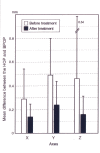Occlusal adjustment using the bite plate-induced occlusal position as a reference position for temporomandibular disorders: a pilot study
- PMID: 20346167
- PMCID: PMC2859855
- DOI: 10.1186/1746-160X-6-5
Occlusal adjustment using the bite plate-induced occlusal position as a reference position for temporomandibular disorders: a pilot study
Abstract
Background: Many researchers have not accepted the use of occlusal treatments for temporomandibular disorders (TMDs). However, a recent report described a discrepancy between the habitual occlusal position (HOP) and the bite plate-induced occlusal position (BPOP) and discussed the relation of this discrepancy to TMD. Therefore, the treatment outcome of evidence-based occlusal adjustments using the bite plate-induced occlusal position (BPOP) as a muscular reference position should be evaluated in patients with TMD.
Methods: The BPOP was defined as the position at which a patient voluntarily closed his or her mouth while sitting in an upright posture after wearing an anterior flat bite plate for 5 minutes and then removing the plate. Twenty-one patients with TMDs underwent occlusal adjustment using the BPOP. The occlusal adjustments were continued until bilateral occlusal contacts were obtained in the BPOP. The treatment outcomes were evaluated using the subjective dysfunction index (SDI) and the Helkimo Clinical Dysfunction Index (CDI) before and after the occlusal adjustments; the changes in these two indices between the first examination and a one-year follow-up examination were then analyzed. In addition, the difference between the HOP and the BPOP was three-dimensionally measured before and after the treatment.
Results: The percentage of symptom-free patients after treatment was 86% according to the SDI and 76% according to the CDI. The changes in the two indices after treatment were significant (p < 0.001). The changes in the mean HOP-BPOP differences on the x-axis (mediolateral) and the y-axis (anteroposterior) were significant (p < 0.05), whereas the change on the z-axis (superoinferior) was not significant (p > 0.1).
Conclusion: Although the results of the present study should be confirmed in other studies, a randomized clinical trial examining occlusal adjustments using the BPOP as a reference position appears to be warranted.
Figures






Similar articles
-
A case report of the symptom-relieving action of an anterior flat plane bite plate for temporomandibular disorder.Open Dent J. 2010 Oct 21;4:218-22. doi: 10.2174/1874210601004010218. Open Dent J. 2010. PMID: 21243070 Free PMC article.
-
Relationship between habitual occlusal position and flat bite plane induced occlusal position in volunteers with and without temporomandibular joint sounds.Cranio. 2005 Jan;23(1):16-21. doi: 10.1179/crn.2005.004. Cranio. 2005. PMID: 15727317
-
Occlusal management for a patient with aural symptoms of unknown etiology: a case report.J Med Case Rep. 2007 Sep 12;1:85. doi: 10.1186/1752-1947-1-85. J Med Case Rep. 2007. PMID: 17848201 Free PMC article.
-
Occlusal adjustment for treating and preventing temporomandibular joint disorders.J Oral Rehabil. 2004 Apr;31(4):287-92. doi: 10.1046/j.1365-2842.2003.01257.x. J Oral Rehabil. 2004. PMID: 15089931 Review.
-
Occlusal treatments in temporomandibular disorders: a qualitative systematic review of randomized controlled trials.Pain. 1999 Dec;83(3):549-560. doi: 10.1016/S0304-3959(99)00160-8. Pain. 1999. PMID: 10568864
Cited by
-
Evaluation of effect of low-level laser therapy on adolescents with temporomandibular disorder: study protocol for a randomized controlled trial.Trials. 2013 Jul 22;14:229. doi: 10.1186/1745-6215-14-229. Trials. 2013. PMID: 23876095 Free PMC article. Clinical Trial.
-
Occlusal interventions for managing temporomandibular disorders.Cochrane Database Syst Rev. 2024 Sep 16;9(9):CD012850. doi: 10.1002/14651858.CD012850.pub2. Cochrane Database Syst Rev. 2024. PMID: 39282765
-
Therapeutic challenges in temporomandibular disorders.Med Pharm Rep. 2024 Jul;97(3):357-369. doi: 10.15386/mpr-2687. Epub 2024 Jul 30. Med Pharm Rep. 2024. PMID: 39234451 Free PMC article.
-
A case report of the symptom-relieving action of an anterior flat plane bite plate for temporomandibular disorder.Open Dent J. 2010 Oct 21;4:218-22. doi: 10.2174/1874210601004010218. Open Dent J. 2010. PMID: 21243070 Free PMC article.
-
Photomodulation in the treatment of chronic pain in patients with temporomandibular disorder: protocol for cost-effectiveness analysis.BMJ Open. 2018 May 5;8(5):e018326. doi: 10.1136/bmjopen-2017-018326. BMJ Open. 2018. PMID: 29730613 Free PMC article.
References
-
- Kopp S, Wenneberg B. Effects of occlusal adjustment and intra-articular injections on temporomandibular joint pain and dysfunction. Acta Odontol Scand. 1981;39:87–96. - PubMed
MeSH terms
Substances
LinkOut - more resources
Full Text Sources
Medical

